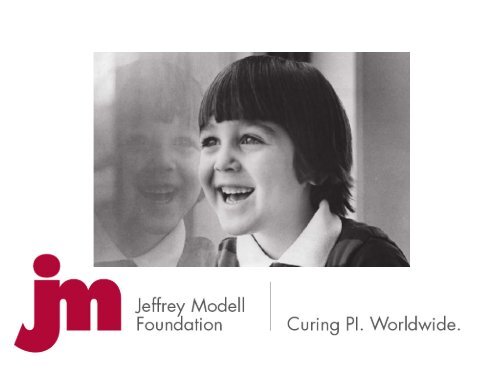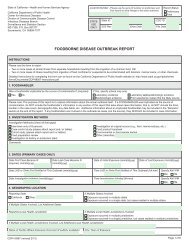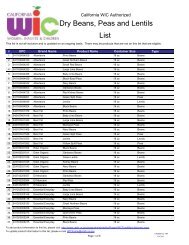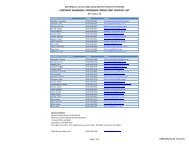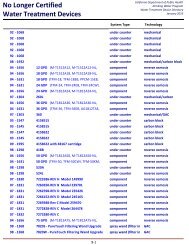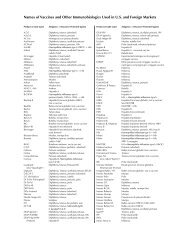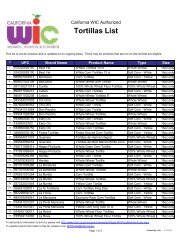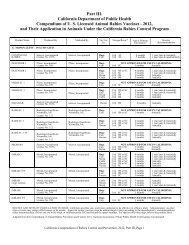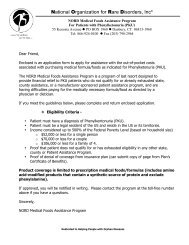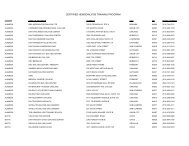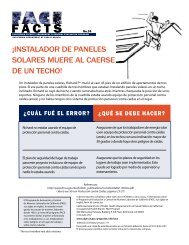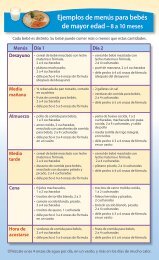Jeffrey Modell Foundation Overview (PDF, 6.4MB) - California ...
Jeffrey Modell Foundation Overview (PDF, 6.4MB) - California ...
Jeffrey Modell Foundation Overview (PDF, 6.4MB) - California ...
You also want an ePaper? Increase the reach of your titles
YUMPU automatically turns print PDFs into web optimized ePapers that Google loves.
Primary Immunodeficiency Diseases<br />
Report in Sacramento, CA<br />
July, 2010
The Mission<br />
JMF’s Mission continues to reach<br />
undiagnosed patients through:<br />
• Physician & Patient Education<br />
• Public Awareness<br />
• Advocacy<br />
• Patient Support<br />
• Basic & Clinical Research<br />
3
Primary Immunodeficiency<br />
The Issue:<br />
Under-Diagnosis<br />
“70% to 90% of all PI patients in the<br />
United States and other regions of the<br />
world are undiagnosed.” ¹<br />
¹ Luigi Notarangelo, MD. Past President of the European Society for<br />
Immunodeficiencies (ESID) and Director of the Expert Committee<br />
on PI for the World Health Organization/IUIS Expert Committee, in<br />
a report to the EU Parliament.<br />
4
How Do We Address The<br />
Issue?<br />
Physician Education and Public Awareness<br />
• Identify suspected and “at risk” patients.<br />
• Refer to JMF Referral Centers Network.<br />
• Provide early and appropriate diagnosis.<br />
• Generate effective intervention and<br />
treatment for lifetime management.<br />
5
Who Do We Reach and<br />
How Do We Reach Them?<br />
What<br />
is<br />
PI?<br />
6
Target Audiences Components<br />
7
Educational Posters to<br />
Physicians<br />
8
NEW!<br />
Posters for Pediatricians!<br />
9
10 Warning Signs Posters Around the World<br />
China<br />
Poland<br />
Finland<br />
France<br />
Hungary Israel Italy<br />
Iran<br />
10<br />
Germany<br />
Japan<br />
Greece<br />
Netherlands<br />
Portugal Russia Spain Sweden<br />
AND MANY MORE…
Posters for School Nurses<br />
& Day Care Centers<br />
Immune System Poster<br />
11
Brochures for Patients<br />
AND<br />
12
Public Service Advertising<br />
• JMF created the first ever Public Service Advertising Campaign on<br />
Primary Immunodeficiencies. The campaign reaches the general<br />
public through television, radio, print, web and airport advertising.<br />
• To date, the campaign has generated over $130 million<br />
in donated media.<br />
• The program is supported by the U.S. Congress, the National<br />
Institutes of Health (NIH), and the U.S. Centers for Disease Control<br />
and Prevention (CDC).<br />
13
As Seen In…<br />
14
As Seen On…<br />
15<br />
AND MANY MORE…
Airports, Shopping Malls, and<br />
High Traffic Billboards!<br />
16<br />
AND MANY MORE…
What was the Impact?<br />
More than 11 million<br />
Hits to JMF Website in the Past Year<br />
More than 500,000<br />
Visits to JMF Website in the Past Year<br />
More than 17,000<br />
Calls to JMF Hotline<br />
More than 24,000<br />
Patients Registered in JMF Database<br />
17
The <strong>Jeffrey</strong> <strong>Modell</strong><br />
Centers Network<br />
As a result of this Awareness<br />
Campaign, JMF created a network of<br />
expert physicians to accommodate<br />
referrals, known as the<br />
<strong>Jeffrey</strong> <strong>Modell</strong> Centers Network<br />
(JMCN).<br />
18
The <strong>Jeffrey</strong> <strong>Modell</strong><br />
Centers Network<br />
448 Physicians at<br />
189 Academic Institutions in<br />
191 Cities and<br />
55 Countries Spanning<br />
6 Continents<br />
19
Where are the<br />
JMF Centers in the U.S.?<br />
9 of the Top 10 and 24 of the Top 30<br />
Pediatric Hospitals*<br />
(*Best Pediatric Hospitals 2010. U.S. News & World Report, June 4, 2010)<br />
20
What Does the Network<br />
Look Like Worldwide?<br />
21
AFRICA CANADA EUROPE Kuwait<br />
Algeria Calgary Austria Lebanon<br />
Bénin Edmonton Belgium Oman<br />
Burkina Faso Halifax Canary Islands Saudi Arabia<br />
Chad Hamilton Denmark United Arab Emirates<br />
Egypt Montreal England<br />
Gabon Quebec Finland UNITED STATES<br />
Guinea Toronto France Alabama<br />
Mali Vancouver Germany Arizona<br />
Mauritania Winnipeg Greece Arkansas<br />
Morocco Ireland <strong>California</strong><br />
Niger EASTERN/CENTRAL EUROPE Italy Colorado<br />
Senegal Albania Netherlands District of Colombia<br />
South Africa Belarus Norway Florida<br />
Togo Bosnia-Herzegovina Portugal Georgia<br />
Tunisia Bulgaria Spain Illinois<br />
Czech Republic Sweden Indiana<br />
ASIA Croatia Switzerland Louisiana<br />
China Estonia Maryland<br />
Hong Kong Hungary LATIN AMERICA Massachusetts<br />
India Latvia Argentina Michigan<br />
Japan Lithuania Brazil Minnesota<br />
Malaysia Macedonia Chile Missouri<br />
Singapore Moldova Colombia Nebraska
What Has Been the Impact of the<br />
Campaign on Early Diagnosis and<br />
Management of Primary<br />
Immunodeficiencies?<br />
23
2010 <strong>Jeffrey</strong> <strong>Modell</strong> Centers<br />
Survey<br />
Number of Patients Referred<br />
6,564<br />
36,076<br />
60,423<br />
2002 – 04 2007 2009<br />
Number of Patients with Identified PI Defects<br />
5,420<br />
30,283<br />
24<br />
45,590<br />
2002 – 04 2007 2009<br />
Number of Patients Followed<br />
5,930<br />
37,544<br />
62,626<br />
2002 – 04 2007 2009
2010 <strong>Jeffrey</strong> <strong>Modell</strong> Centers Survey<br />
(Continued…)<br />
Number of Patients Receiving Treatment<br />
3,038<br />
14,062<br />
2002-04 2007 2009<br />
22,300<br />
25<br />
Number of Patients Receiving IgG Therapy<br />
2002-04 2007 2009<br />
Number of Diagnostic Tests Performed<br />
17,596<br />
367,090<br />
662,952<br />
2002-04 2007 2009<br />
1,678<br />
6,822<br />
12,598
Survey of <strong>Jeffrey</strong> <strong>Modell</strong> Centers<br />
Global 2010<br />
Total = 45,590<br />
26
Survey of <strong>Jeffrey</strong> <strong>Modell</strong> Centers<br />
United States 2010<br />
Total = 13,352<br />
27
Survey of <strong>Jeffrey</strong> <strong>Modell</strong> Centers<br />
International 2010<br />
Total = 32,283<br />
28
Survey of <strong>Jeffrey</strong> <strong>Modell</strong> Centers<br />
29
2010 – 8 Major Immunodeficiency Groups<br />
30
2010 <strong>Jeffrey</strong> <strong>Modell</strong> Centers Survey<br />
Participants<br />
31
JMCN Comparison with ESID<br />
32<br />
32
What Does<br />
This Data Tell Us?<br />
� Specific defects of 45,590 patients!<br />
� Where they are being treated!<br />
� Who is treating them!<br />
� How they are being treated!<br />
33
What about the Quality of<br />
Life for<br />
Diagnosed vs. Undiagnosed?<br />
34
6.4<br />
1.8<br />
Undiagnosed Patients Diagnosed Patients<br />
70.9<br />
Quality of Life Impact<br />
Number of Acute Infections<br />
Number of Physician/<br />
Hospital/ER Visits<br />
11.8<br />
Undiagnosed Patients Diagnosed Patients<br />
35<br />
4.3<br />
Number of Severe Infections<br />
0.6<br />
Undiagnosed Patients Diagnosed Patients<br />
2.8<br />
Number of Pneumonias<br />
0.6<br />
Undiagnosed Patients Diagnosed Patients
44.7<br />
12.6<br />
Undiagnosed Patients Diagnosed Patients<br />
19.2<br />
Quality of Life Impact<br />
(Continued…)<br />
Number of Days with<br />
Chronic Infections<br />
5.1<br />
Undiagnosed Patients Diagnosed Patients<br />
Number of Days<br />
in Hospital<br />
36<br />
166.2<br />
72.9<br />
Undiagnosed Patients Diagnosed Patients<br />
33.9<br />
Number of Days<br />
on Antibiotics<br />
Number of School/Work<br />
Days Missed<br />
8.9<br />
Undiagnosed Patients Diagnosed Patients
What is the Economic Impact?<br />
Condition Cost per patient<br />
per episode/day<br />
Chronic infections<br />
Acute infections<br />
Severe infections<br />
Bacterial<br />
pneumonias<br />
Hospitalizations<br />
Physician/Hosp-<br />
ital/ER visits<br />
Antibiotics<br />
School/Work days<br />
missed<br />
$36.33<br />
(per day)<br />
$2,950<br />
(per episode)<br />
$5,708<br />
(per episode)<br />
$7,529<br />
(per episode)<br />
$1,158<br />
(per day)<br />
$125<br />
(per visit)<br />
$4.25<br />
(per day)<br />
$136.40<br />
(per day)<br />
Pre Diagnosis Post Diagnosis<br />
# of<br />
episodes<br />
Annual cost<br />
per patient<br />
37<br />
# of<br />
episodes<br />
Annual<br />
cost per<br />
patient<br />
Annual savings<br />
per patient<br />
44.7 $1,623 12.6 $457 $1,166<br />
6.4 $18,880 1.8 $5,310 $13,570<br />
4.3 $25,544 0.6 $3,424 $21,119<br />
2.8 $21,081 0.6 $4,517 $16,564<br />
19.2 $22,223 5.1 $5,905 $16,328<br />
70.9 $8,862 11.8 $1,475 $7,387<br />
166.2 $706 72.9 $309 $397<br />
33.9 $4,632 8.9 $1,213 $3,410<br />
Totals per patient $102,552 $22,610 $79,942
Sources for<br />
Economic Study<br />
• Hospital Costs and Utilization Project (HCUP) Data, was<br />
employed for hospital charges and length of stay under<br />
the Agency for Healthcare Research and Quality<br />
(AHRQ).<br />
• Centers for Medical and Medicaid Services (CMS)<br />
provided hospital billings.<br />
• AETNA website provided outpatient changes based on<br />
“in network” centers.<br />
• The study does not include costs of patients/parents<br />
lost wages, transportation, or quality adjusted life years<br />
benefits for diagnosed and treated patients.<br />
38
Physicians’ Conclusion on<br />
Quality of Life & Economic Impact<br />
On Diagnosed Patients<br />
The physicians in the <strong>Jeffrey</strong> <strong>Modell</strong> Centers<br />
Network (JMCN) reported an average annual<br />
decrease of 70% in the number of severe<br />
infections, physician, hospital and emergency<br />
room visits, pneumonias, school/work days<br />
missed, days in the hospital, acute infections,<br />
and days with chronic infections.<br />
39
Physicians’ Conclusion on<br />
Quality of Life & Economic Impact<br />
On Diagnosed Patients<br />
• The physician reports reflect overall cost<br />
savings to the healthcare system comparing<br />
undiagnosed and diagnosed/ treated PI<br />
patients.<br />
• Cost savings average $80,000 per patient, per<br />
year.<br />
• This data translates to a cost savings of<br />
$40 billion annually to the healthcare system in<br />
the United States.<br />
40
All of this Data was published<br />
in a<br />
Scientific Peer Reviewed Journal:<br />
<strong>Modell</strong>, F., Puente, D., <strong>Modell</strong>, V. From genotype to phenotype.<br />
Further studies measuring the impact of a Physician Education and<br />
Public Awareness Campaign on early diagnosis and management of<br />
Primary Immunodeficiencies. Immunologic Research. Humana<br />
Press, an imprint of Springer Publishing. 2009. 44(1-<br />
3):132-49<br />
41
JMF Program Accomplishments<br />
in the Past 12 Months<br />
• 52% increase in the number of funded <strong>Jeffrey</strong> <strong>Modell</strong> Diagnostic<br />
and Research Centers, expanding from 50 to 76.<br />
• 25% increase in the number of physicians participating in the<br />
JMCN from 357 to 448<br />
• The number of academic institutions in the network increased<br />
from 157 to 189<br />
• 27% increase in the number of patients identified in the<br />
network with specific defects from 35, 695 to 45,590.<br />
42
JMF Program Accomplishments<br />
in the Past 12 Months<br />
• $18 million of donated media contributed to the Awareness<br />
Campaign with an overall average of $1.5 million per month.<br />
• Production of new 10 Warning Signs Poster, Adult 10 Warning<br />
Signs Poster, “Cartoon Version” in English and Spanish, Slim<br />
Jim, Accordion Folder in English and Spanish and New Immune<br />
System Poster Kit.<br />
• Distribution of newly published materials to 30,000<br />
pediatricians, as well as sub specialists in emergency medicine,<br />
infectious disease, and pulmonary disease.<br />
• Distribution of newly published materials to 18,000 physicians in<br />
internal medicine and family practitioners, as well as 15,000<br />
school nurses and day care centers, nationwide.<br />
43
JMF Program Accomplishments<br />
in the Past 12 Months<br />
• 22 Kid’s Days in regions across the US. Featuring Major League<br />
Baseball Games, Visits to the Zoo, Harbor Cruise, Football games,<br />
museums, and more!<br />
• 34% increase in new WIN grants to patient organizations<br />
worldwide, bringing the total WIN Grants awarded to 104.<br />
• 8 Peer Reviewed Fellowships awarded through –<br />
the <strong>Jeffrey</strong> <strong>Modell</strong> Centers Network (4) as well as Seattle<br />
Children’s Hospital (1) and Mount Sinai School of Medicine (3),<br />
totaling $500,000 in the past year.<br />
• Fellowship funding is provided to the brightest investigators<br />
around the world with focus on Primary Immunodeficiencies.<br />
44
JMF Program Accomplishments<br />
in the Past 12 Months<br />
• Each awarded Fellow from the <strong>Jeffrey</strong> <strong>Modell</strong> Centers Network<br />
will be mentored at a leading institution by our expert<br />
investigators.<br />
• Endowed Chair dedicated at Children’s Hospital Boston, MA.<br />
• <strong>Jeffrey</strong> <strong>Modell</strong> Centers Network peer reviewed research awards<br />
totaling $250,000 in the past year. This program is a<br />
collaboration with the National Institutes of Health (NIH).<br />
• <strong>Jeffrey</strong> <strong>Modell</strong> Immunology Center at Harvard Medical School,<br />
continuing academic programs, symposia, and seminars,<br />
throughout 2009-2010.<br />
45
EU Parliament<br />
• JMF’s initiative at the EU Parliament “Call to Action” has<br />
generated 121 signatories to-date.<br />
• “HOPE” Hospital System is a signatory covering 15,000<br />
leading hospitals throughout Europe.<br />
• World Health Organization is in discussion with the JMF<br />
for a collaboration going forward.<br />
46
Newborn Screening<br />
• Secretary of HHS adds SCID to the Federal<br />
Core Panel for Newborn Screening.<br />
• JMF has advocated for this program over past<br />
9½ years. This is the first defect to be added<br />
to the core panel.<br />
• The State of Wisconsin identified and cured<br />
the first Newborn screened with SCID.<br />
47
Newborn Screening<br />
• Late diagnosis of SCID costs an average of $2.2 million<br />
according to the Children’s Hospital in Wisconsin.<br />
• Early diagnosis & treatment, in the first 3 months of<br />
life, ranges in cost from $10,000 to $100,000.<br />
• Cost to screen using TREC’s assay is $4-$5 per baby<br />
• 10 States are implementing screening programs for<br />
SCID at this time.<br />
• JMF has reached out to ALL Governors and State<br />
Public Health Commissioners, urging startup of<br />
newborn screening programs for SCID.<br />
48
NEW!<br />
NEW!<br />
TRACE PROGRAM<br />
Tracking of Reported<br />
Activity<br />
for Clinical Evaluation<br />
50
TRACE<br />
Program Studies<br />
I. The TRACE program “drills down” into the JMF Survey<br />
data by specific defect. For example, if we did a<br />
TRACE Program study on CVID, we would be able to<br />
identify the following:<br />
1. Overall number of CVID patients globally<br />
2. Number of CVID patients identified in the 9<br />
major regions<br />
3. Number of CVID patients identified in each<br />
country<br />
4. Number of CVID patients identified in each<br />
state, city, and by institution<br />
51<br />
NEW!<br />
NEW!
TRACE<br />
Program Studies<br />
II. In each of the 4 categories we can determine:<br />
1. The number and percentage of CVID patients related to 100% of all<br />
patients.<br />
2. The number and percentage of CVID patients receiving treatment.<br />
3. The number and percentage of CVID patients receiving IG therapy.<br />
4. The number and percentage of patients with CVID compared to all<br />
other PI diseases, at the sites.<br />
5. The number and percentage of patients with CVID compared to all<br />
other antibody deficiencies other than CVID, at the sites.<br />
6. The number and percentage of patients with antibody deficiencies<br />
including CVID compared to the other 7 major Immunodeficiency<br />
categories.<br />
52<br />
NEW!<br />
NEW!
NEW!<br />
NEW!<br />
TRACE<br />
Program Studies<br />
Continued<br />
III. A trend study, over a period of 5 years that will<br />
show the # and % of patients with CVID globally,<br />
by region, country, city, and at a particular<br />
institution, for all categories.<br />
IV. This retrospective study can be applied to any of<br />
the 43 defects but our recommendation would be<br />
to initially study CVID and XLA.<br />
V. A Second, Phase 2, prospective study may be<br />
considered after Phase 1.<br />
53
Genome-wide Sequencing in the<br />
Newborn Screening Program for SCID<br />
• The Newborn Screening program for SCID has<br />
been successful in Wisconsin and Massachusetts.<br />
Many additional states are starting new programs.<br />
• One scenario that has arisen is that newborns with<br />
very low T cell count were picked up by TRECs<br />
assay screen but were not typical of SCID<br />
• The baby appears to have a serious condition but<br />
not one that should necessarily require a Bone<br />
Marrow Transplant<br />
54<br />
NEW!<br />
NEW!
Genome-wide Sequencing in the<br />
Newborn Screening Program for SCID<br />
NEW!<br />
NEW!<br />
• On the other hand, if we wait, significant and<br />
overwhelming infectious complications may occur making<br />
it too late to transplant.<br />
• Evaluation of those newborns to find the molecular defect<br />
can take months or even years to complete.<br />
• The Wisconsin newborn screening team believes that<br />
genome wide sequencing, is the most expeditious,<br />
informative and cost effective method to evaluate infants<br />
with profound T-cell Lymphopenia, not typical of SCID.<br />
The sequencing should provide the specific mutation.<br />
• JMF initiated funding with the State of Wisconsin and<br />
entered an Illumina Individual Genome Sequencing<br />
Services Agreement.<br />
55
NEW!<br />
NEW!<br />
TROUGH Level<br />
Study Plans for 2011<br />
• This is a multicenter research project<br />
• 8 Children’s Hospitals and Principal Investigators at<br />
these institutions are currently participating in this<br />
study.<br />
• The goal is to determine biological IgG levels for<br />
patients with CVID and XLA, to remain infection free.<br />
• The Web based program to compile data for the 8<br />
hospital consortium has been developed an refined.<br />
• Joint IRB approval is now underway.<br />
• Patient data entry forms will be finalized to determine<br />
number of data fields in the questionnaire, when<br />
enrolling a patient in the study.<br />
56
What is<br />
Software for<br />
Primary<br />
I mmunodeficiency<br />
Recognition<br />
I ntervention and<br />
Tracking<br />
57<br />
?
’s Mission<br />
1. Disease Prevention<br />
2. Electronic Medical Tracking<br />
3. Reduction of Healthcare Costs<br />
4. Improved Quality of Life for Patients<br />
58
What Data Will Generate?<br />
HIPAA-compliant, de-identified reports will<br />
describe the health plan’s population via the<br />
following metrics related to PI:<br />
• Population <strong>Overview</strong> (Gender and Age)<br />
• Distribution by PI Warning Sign<br />
• Distribution by Risk Category and by<br />
Number of Warning Signs (High,<br />
Moderate, and Low)<br />
• Antibiotic Utilization<br />
59
Analyzer<br />
Pilot Testing<br />
Three health plans pilot tested the SPIRIT<br />
Analyzer utilizing their plans’ records and<br />
provided JMF with top-level, de-identified,<br />
blinded data.<br />
A summary comparing their results follows...<br />
60
Analyzer Data Summary From Beta Benchmark<br />
and Pilot Sites<br />
61
Analyzer<br />
Data Summary From Beta Benchmark and Pilot Sites (Continued…)<br />
62
Analyzer<br />
Data Summary From Beta Benchmark and Pilot Sites (Continued…)<br />
All of the ratios are consistent with<br />
NIH and CDC estimates of<br />
incidence and prevalence.<br />
63
“At Risk”<br />
What Happens To<br />
Patients Flagged By ?<br />
• The <strong>Jeffrey</strong> <strong>Modell</strong> Centers Network continually<br />
identifies outcomes of “high risk” patients.<br />
• A number of these “high risk” patients, even after<br />
definitive diagnosis, require periodic monitoring but no<br />
specific intervention.<br />
• Others require the use of prophylactic antibiotics and in<br />
some cases immunoglobulin therapy.<br />
• This data provided by the physicians and the <strong>Jeffrey</strong><br />
<strong>Modell</strong> Centers Network is helpful as a guide to<br />
anticipated outcomes for “high” and “moderate” risk<br />
patients flagged by SPIRIT.<br />
64
Anticipated Outcomes for “High Risk” patients<br />
flagged by<br />
(Information Derived from the <strong>Jeffrey</strong> <strong>Modell</strong> Centers Network)<br />
65
Recently JMF Presented the SPIRIT<br />
Analyzer to members of the<br />
Managed Care Network.<br />
Managed Care Network (MCN) includes senior executives<br />
and Medical/Pharmacy Directors at regional and national<br />
health plans. Together they represent nearly 200 million<br />
covered lives.<br />
66
Analyzer<br />
When Surveyed, participants reported as follows:<br />
• 81 % agreed or strongly agreed that “Primary<br />
Immunodeficiency is a concern that should be<br />
monitored in my health plan”<br />
• 75% agreed or strongly agreed that “early<br />
identification of Primary Immunodeficiencies can<br />
improve patient’s quality of life and reduce health<br />
care costs”<br />
• 66% agreed or strongly agreed that “JMF’s SPIRIT<br />
Analyzer represents an excellent opportunity to<br />
screen for undiagnosed patients in my health plan”<br />
67
Why is Right for<br />
you?<br />
• No cost to implement this<br />
software.<br />
• No risk to your current database.<br />
• Can easily do a test-run of the<br />
software with a small portion of<br />
your database.<br />
• Potential to save huge healthcare<br />
dollars<br />
68
Why is Right for you?<br />
• Technical support<br />
• User Guide, FAQs, and hotline<br />
contact included with software.<br />
No additional personnel or resources are<br />
required to make use of the SPIRIT<br />
Analyzer.<br />
69
Analyzer<br />
System Requirements<br />
Hardware<br />
Intel® Pentium® III 600MHz or equivalent<br />
512 MB RAM (1 GB RAM or more strongly recommended)<br />
1GB + (3 X Data file size) free disk space<br />
32-bit Video (1024 x 768 display)<br />
Operating System<br />
Microsoft® Windows® 2000, XP, Vista<br />
Software Applications<br />
Adobe® Reader® 6.0<br />
Microsoft® .NET Framework 1.1<br />
Processing Time<br />
Processing (run) times will vary based on computer speed and file size. The amount of<br />
computer memory (RAM) and the size of the dataset are the biggest factors affecting<br />
execution run time. Desktop computers generally run faster than notebook computers<br />
with the same technical specifications. A notebook computer with Pentium IV, 1GB RAM,<br />
and 20GB of free disk space can analyze 1,000,000 pharmacy and medical<br />
claims in approximately 30 minutes.<br />
70
How to Begin ?<br />
There are two ways to obtain this software:<br />
1. Online: www.info4pi.org:<br />
a. Scroll down to “Professional Medical Information”<br />
b. Click on “SPIRIT Analyzer”<br />
c. Complete brief request form<br />
OR<br />
2. Email the <strong>Jeffrey</strong> <strong>Modell</strong> <strong>Foundation</strong> at<br />
Info@JMFWorld.org with the following<br />
information:<br />
a. Company/Group Affiliation<br />
b. Your Contact Information<br />
71
Let’s Begin!<br />
It’s time to catch the


